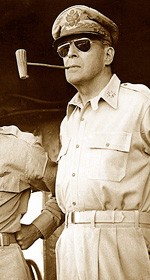 Leading Blog | Posts by Month |
 Leading Blog | Posts by Month |
05.31.10

LeadershipNow 140: May 2010 Compilation
Posted by Michael McKinney at 12:29 PM

General Douglas MacArthur's Principles of LeadershipGeneral Alexander M. Haig, the former Secretary of State who served in SCAP (Supreme Commander for the Allied Powers) headquarters during the occupation of Japan and in Korea, recalls a story of MacArthur's style of leadership as a young Brigadier in World War I:He was in the trenches with a unit that had to seize some ground and it was a very difficult task of leaping out of the trenches and charging through machine gun fire to the objective and said to the young officer in command, he said, "Young man, if you do this and you seize those enemy positions, I'm going to give you a Silver Star." And, the young fellow looked at him. He said, "No, come to think of it," he said, "I know you're going to do it," and he pinned the silver star on the young officer's chest and needless to say, that young fellow charged at extra speed to the objective at the other end. So, this was the kind of leadership that Douglas MacArthur exercised.MacArthur's confidence was derived from the depth of his convictions. William Addleman Ganoe recalled in his 1962 book, MacArthur Close-up: An Unauthorized Portrait, his service to MacArthur at West Point. During World War II, he created a list of questions with General Jacob Devers, they called The MacArthur Tenets. They reflect the people-management traits he had observed in MacArthur. Widely applicable, he wrote, “I found all those who had no troubles from their charges, from General Sun Tzu in China long ago to George Eastman of Kodak fame, followed the same pattern almost to the letter." 
Posted by Michael McKinney at 09:27 AM
05.30.10

Why is the Essence of Leadership So Hard to Grasp?Why is the essence of leadership so hard to grasp? In The Leadership Illusion, authors Tony Hall and Karen Janman attribute it to the way in which we view leaders. We tend to over-emphasize character and underplay context. This gets to the heart of the leadership illusion: seeing leaders and leadership in one dimension. We ignore the context. When we evaluate the causes of the success or failure of leaders, we tend to “focus predominantly on the individual (sometimes the context), but very rarely both at the same time. The need to see someone as “fabulously successful or woefully inadequate” is strong. This causes us to underestimate the importance of context and connections when thinking about leaders and leadership. Leadership is not a solo performance.The leadership illusion also influences how we predict leaders and train for leadership. When examining what makes for successful leadership we search for personal attributes and tend to ignore their context and connections. This caused Harvard professor Richard Chait to refer to some leadership researchers as organizational meteorologists. “His view being that we have as much a chance of predicting whether it will rain or shine three weeks hence as we have of reliably finding ourselves a suitable leader.” They write, “There are some aspects, some attributes, of an individual that make them successful as a leader. But we need to evaluate the person and the context in order to be clearer about whether what we perceive is real or illusory.” Additionally, leaders should not be developed not in a vacuum but in the context within which they are to lead and in an environment that is fully supportive of that. “It doesn’t matter how effective a development technique may be in improving individual skills, if the organizational context is not supportive or consistent with the skills you have developed, the learning is likely to have little impact….There are far too many organizations that invest significant time and money in developing their people, but forget to develop or change the organization in tandem.” Do we develop strengths or weaknesses? “Our view is that you work on the skills and abilities that you need in order to perform effectively in your context….the end result being that development may encompass both strengths and weaknesses, as long as they are relevant to performance.” The demand placed on us by living in such a connected world, has lead Hall and Janman to the concept of network leadership. Relationships matter. Developing the right kind of social capital is an increasingly important function for effective leaders. What kind of social capital to develop is context dependent. Network leaders “bridge and they bond. They exhibit a balanced form of leadership that mixes the old with the new; combine radical approaches with received wisdom; and develop both breadth and depth of relationships.” Leaders are not independent entities. Leaders do not exist by themselves in organizational space, but are spatially extended (through their networks). In this way the concept “individual leader” loses its meaning. … The network thus becomes an irreducible element of physical description.
Posted by Michael McKinney at 08:00 AM
05.26.10

The Face Game at ZapposTony Hsieh, CEO of Zappos, has made the company culture the number one priority at Zappos. For them, building community is what it is all about. It has become part of their brand. As he writes in Building Happiness, that while some of the things they do have grown organically, there are a few things that have been more purposeful and planned. One way to help build community is an internal game they call, The Face Game. He writes:In most companies, logging in to the computer systems requires a login and a password. At Zappos, an additional step is required: a photo of a randomly selected employee is displayed, and the user is given a multiple-choice test to name that employee. Afterward, the profile and bio of that employee are shown, so that everyone can learn more about each other. Although there is no penalty for giving the wrong answer, we do keep a record of everyone’s score. We’re always on the lookout for ways to improve our company culture, no matter how unconventional or counterintuitive the approach may be.
Posted by Michael McKinney at 02:53 PM
05.24.10

Otheresteem: Building Relationships by Valuing OthersMonica Diaz has written a short but key book on developing productive and sustainable relationships. Otheresteem is about how valuing others can enhance your work, your family, your business and yourself.Otheresteem is a word to describe the value you have of another person and the feeling that that view brings out in you. It’s begins by taking responsibility for the quality of the relationships you have with others. Diaz says that otheresteem is a practice that involves four behaviors: Acceptance: Valuing others for who they are now. Not trying to change them, but to understand them. Appreciation: Valuing others means that you can—and make an effort to—see things that you value in them. “If we can learn to appreciate something in the other person, we can build a relationship different from competitiveness, from hatred, from alienation.” Expectation: Valuing others not just for what they are, but for what you know they can be. Gratitude: Feeling and demonstrating gratitude for the relationship you have with another is a natural result of acceptance, appreciation and expectation. “As with appreciation, being grateful for my relationship with you does not mean I approve of your every move…. It means I have become wise enough to find some small jewel in this exchange.” In building your otheresteem remember, “You are working on yourself, not them. The primary intention is to change the way you perceive and treat them, to build on the value you place on them as collaborators.” Understand that you are only to change yourself, and that is exactly what you are setting off to do: change the way you value this person, regardless of your past experiences together and without a set agenda of how you expect them to contribute to the cause. The more you let go of preconceived notions of what the other must do, the more effective your quest for collaboration and mutual learning.Through examples and the lessons learned from them, Diaz demonstrates how otheresteem is possible in not only the workplace, but anywhere you find people in your life. It is not unusual for people to wonder, “Yeah, but if it am busy valuing others—especially in the workplace—then what about me? Don’t I get left behind?” As odd as it seems, otheresteem—esteeming others—is the antidote to the question, “What about me?” By esteeming others you are building your self-esteem—and we greatly improve the world we live in. Why Otheresteem? Because of the kind of person it makes you. Of Related Interest:
Posted by Michael McKinney at 10:31 PM
05.21.10

Dreamers, Doers and Incrementalists. Which One Are You?Scott Belsky speculates that “having an idea” is perhaps only 1 percent of the journey. Ideas don’t just happen. You have to make them happen. That is what Making Ideas Happen is all about. Anyone can develop the capability to make an idea happen. That capacity is derived from a combination of forces that he builds on in detail:Making Ideas Happen = Ideas + Organization + Communal forces + Leadership capability Organization enables you to manage and ultimately execute your ideas. Belsky’s Action Method helps those with creative tendencies live and work with a bias toward action. By broadcasting your ideas you put communal forces to work for you. They will help you to refine your ideas. Finally, a specific leadership capability is required to manage the “delicate chemistry of a creative team” and to help them to withstand and capitalize on the inevitable doubts and pressures that will be felt along the way. Belsky identifies three broad categories of creatives: the Dreamer, the Doer, and the Incrementalist. Dreamers are always generating new ideas. They’re always starting new projects. “Dreamers are fun to be around, but they struggle to stay focused. In their ideas frenzy, they are liable to forget to return phone calls, complete current projects, even pay the rent. While Dreamers are more likely than anyone to conceive of brilliant solutions, they are less likely to follow through." Doers are focused on the logistics of execution. They ask, “How are we going to implement this?” “While Dreamers will quickly fall in love with an idea, Doers will start with doubt and chip away at the idea until they love it (or, often, discount it). As Doers break an idea down, they become action-oriented organizers and valuable stewards." Incrementalists have the capacity to play both roles. “An Incrementalist is able to bask in idea generation, distill the Action Steps needed, and then push ideas into action with tenacity.” Incrementalists may seem like the best of all worlds, but they “have the tendency to conceive and execute too many ideas simply because they can. This rare capability can lead to an overwhelming set of responsibilities to maintain multiple projects at the expense of ever making one particular project an extraordinary success.” All three types have their strengths and weaknesses. The answer here is to collaborate. You have to pick a partner carefully, but when it works, “ideas can flourish on a much larger scale.” Doers and Dreamers are a good fit because of their very different strengths. If you work in isolation as a Dreamer, your ideas will swiftly come and go without accountability and stimulation from others. As a Doer, you may struggle to come up with new ideas and solutions in favor of becoming mired in the details. As an Incrementalist, you will likely conceive of and execute a raft of projects that eventually sputter and grow stagnant, short of their true reach. No matter which type you fall into, developing meaningful partnerships will make you more effective.
Posted by Michael McKinney at 07:37 PM
05.20.10

Share Your Ideas Liberally Scott Belsky makes the case in Making Ideas Happen for sharing your ideas with others. To make it part of the corporate culture you may even have to “move people around and literally share people to share ideas.” Former Belsky colleague Steve Kerr, even went so far as to say that “’hording information is an integrity violation,’” making the case that failing to share a best practice with your team or department was essentially akin to stealing from the company.” Belsky explains the rationale for sharing ideas liberally: The notion of “sharing ideas liberally” defines the natural instinct to keep your ideas a secret. Yet, among the hundreds of successful creatives I’ve interviewed, a fearless approach to sharing ideas is one of the most common attributes. Why? Because having the idea is just one tiny step along the road to making that idea happen. During the journey, communal forces are instrumental in refining the very substance of the idea, holding us accountable for making it happen, building a network that will push us to go above and beyond, providing us with valuable material and emotional support, and spreading the word to attract resources and publicity. By sharing your idea, you take the first step in creating the community that will act as a catalyst to making it happen. He who receives an idea from me, receives instruction himself without lessening mine; as he who lights his taper at mine, receives light without darkening mine. That ideas should spread from one to another over the globe, for the moral and mutual instruction of man, and improvement of his condition, seems to have been particularly and benevolently designed by nature. Adapted from Making Ideas Happen: Overcoming the Obstacles Between Vision & Reality by Scott Belsky.
Posted by Michael McKinney at 04:31 PM
05.19.10

Where Does Innovation Begin?Robert Brands is an innovation coach with a lot of experience with real-world product innovation. It’s no surprise then that his book, Robert’s Rules of Innovation: A 10-Step Program for Corporate Survival, is heavy on the consumer products side of innovation. Nevertheless, the 10 rules he presents can be applied in any setting.Innovation is first a leadership issue. Innovation begins with the Chief Executive Officer who has to be the Chief Innovation Officer. It is the important first step. Throughout the book he gleans insights from other innovators he has worked with like Jill McCurdy of the Innovation Center of the Rexam’s Plastics Division. She offers a few keys to getting started:
Overcommunicate and underpromise “without hyperbole or pie-in-the-sky verbiage. Keep it simple. Keep it focused. Keep it real.” And remember communication is two-way. “Knock down the barriers,” Brands says, “that keep silos apart by creating cross-functional teams between groups that don’t typically interact.” Provide accountability and ownership. “Even the most technical of innovations require leaders with superior people and communications skills.” Brands’ book details 10 rules to create and sustain a culture of innovation:
Posted by Michael McKinney at 04:44 PM
05.17.10

Serve to Lead: Make Your Life a Masterpiece of Service Everyone can be great because everyone can serve. You don’t have to have a college degree to serve. You don’t have to make your subject and your verb agree to serve…. You only need a heart full of grace, a soul generated by love.“Everyone can lead because everyone can serve,” says James Strock. “When service is the basis of leadership, everyone can be a leader.” What’s more, “We’re in a new era, with new rules, new ways to serve—and much greater accountability.” In a new edition, Serve to Lead 2.0 puts the focus of leadership where it should be. Too often, people think of leadership as being about the leader. A leader who serves has greater influence. Service—not control—leads to trust and increased influence. In an excellent chapter on management, Strock helps to place management and leadership in perspective and explains some of the nuances of tough love and accountability. “Management is encompassed within leadership.” As leaders, we must develop management skills. “Ultimately, management is a key to extraordinary service. Individual performance has the limitations of an individual. You may be a virtuoso. Yet, if you are determined to express your individuality in a more expansive way, you must develop management skills and engage others in a larger enterprise.Filled with examples and quotes, Serve to Lead 2.0 is well thought out and one of the best books you’ll read on how to think about service and how to get your leadership to be one of service. Strock urges us to make our life a masterpiece of service. It begins by asking the question—who am I serving—throughout our life, minute by minute, hour by hour, day by day. Importantly, it is not a question that we should apply to only one area of our life. It should be an approach we take in all areas of our life—our time, our money, our relationships, and thoughts. As an ongoing practice, he suggests we continually ask ourselves four questions: Who am I serving? How can I best serve? Am I making my unique contribution? Am I getting better every day? Service isn’t easy. It doesn’t always get noticed, but it is what leading is all about. If that is hard to swallow, you need to ask yourself, why do I want to lead? How many people are trapped in their everyday habits: part numb, part frightened, part indifferent? To have a better life we must keep choosing how we’re living.   
Posted by Michael McKinney at 01:42 PM
05.12.10

lead:ology - What is Leadership?
The fact that there are so many and assorted definitions of leadership speaks to the very human aspect of leadership. It is as varied as there are leaders and leadership needs. A good definition needs to allow many perspectives. It should create awareness. It should include leaders at all levels. It should raise more questions than it answers. It should lead to who, why, where, and how. Who is a leader? Why do they lead? In what context? When are they leading? How do we know? How do we evaluate it? Our definition of leadership is important because it mirrors our perspective of leadership. Do we believe leaders are born or are they made? Is it for a select few, or can anyone make a difference? A definition of good leadership is different from a definition of what leadership is. Defining good leadership is a separate issue. Leadership, like power, is value-neutral. It isn’t inherently good or bad. It becomes good or bad depending on what we do with it. And humankind has done all kinds of things with it. Consequently, we have good leaders and bad leaders. Some definitions try to define away bad leaders as if to say, “Bad leaders cannot really be considered leaders at all.” It is an attempt to define away our humanity. The problem is bad leaders are very real. They exist and they cause harm. With their leadership skills, they play upon the worst in people and lead them into destructive thinking and behavior. This cavalier approach to leadership is a disservice to the study of leadership and undermines a serious understanding of the potential of leadership for good or bad. Good leaders and bad leaders have a lot more in common when it comes to leadership than we might like to think. Being human, we have the potential to corrupt anything we touch and an awareness of this is important. Archbishop Desmond Tutu said that his experience has taught him two things: “we have this extraordinary capacity for good” and we “have a remarkable capacity for evil.” Armed with this understanding and the examples of those who have sadly corrupted those they led, we can better appreciate what we can do to maximize good leadership and minimize bad leadership. Defining bad leadership away undermines the importance of the values we associate with good leadership such as good character, humility, integrity, and selflessness. A definition that allows that some leadership is bad can help to save us from our own hubris. Most definitions create an impoverished view of leadership. Narrow business-centric definitions are not inclusive of all leaders at all levels and in all contexts. They are misleading. Leadership is far more complex and varied than most definitions would lead us to believe. Most definitions still reinforce the idea that leadership is positional. Acts of leadership by leaders with no title are dismissed. No definition for the study of leadership should be considered if it does not reflect the rich variety of leadership and is not inclusive of all potential leaders. A working definition for the study of leadership needs to include leaders of all kinds, not just the leaders we find easy to identify. Certainly, leadership is about shared values, vision and results. It is exemplified through the work people do, the attitudes they adopt and the potential they realize. But it all begins with an intention to influence others. Most definitions tackle the how of leadership not the what. It is the how where we spend a lifetime working to improve our effectiveness at influencing. The what of leadership is simpler. Leadership is intentional influence.
Posted by Michael McKinney at 12:21 PM
05.11.10

Leading Views: Leadership Without a Pinch of Fear is Like Cooking Without Salt On July 1, Nitin Nohria will become the tenth dean of Harvard Business School. He brings with him a new perspective that is much needed at this time. Harvard professor Rosabeth Moss Kanter told Stefan Stern of the Financial Times, “This is about leaders who take responsibility. I could characterize it as the start of a shift to moral capitalism. And not just as a corrective. This is something new.” On July 1, Nitin Nohria will become the tenth dean of Harvard Business School. He brings with him a new perspective that is much needed at this time. Harvard professor Rosabeth Moss Kanter told Stefan Stern of the Financial Times, “This is about leaders who take responsibility. I could characterize it as the start of a shift to moral capitalism. And not just as a corrective. This is something new.”
Nohria is by all reports a collaborative leader and a reflective one as well. In the 2000 book, The Arc of Ambition that he co-authored with James Champy, they write about the need for positive anxiety in leadership and the need to share power: Fear chills minds, numbs souls, kills initiative and businesses. And yet, our arsenal can’t be entirely devoid of fear. A certain amount of fear is necessary to improve performance—assuming that by fear one means positive anxiety, the edgy urge to do a great job and not let down the team. Those incapable of instilling that feeling throughout a company may well invite disrespect for the common enterprise. They flirt with apathy and mediocrity. Leadership without a pinch of fear is like cooking without salt. But the ambitious don’t take advice easily…Once they are in charge, they may feel their position threatened by other opinions, particularly those that differ from their own. More likely, ambitious people just believe that they are right. In their minds, they suffer no fools. Time is too short for that. Sometimes, they also select men and women for their boards who reflect their own opinions. That’s a dangerous practice, especially if somewhere in the exercise of your ambition, you are wrong (it happens, you know). Someone needs to be present who dares to disagree with you. Coming to grips with our own ambitions is ultimately a forewarning about the myth of omnipotence. No solo ruler of a complex can ever have enough creativity, knowledge, and time to make the right decisions single-handedly. His or her survival depends on sowing and reaping the brilliant work of others. By sacrificing the appearance of power, we achieve the substance—the real reward—of power.
Posted by Michael McKinney at 10:03 AM
05.05.10

Are You Living Out Your Why?Reduced to a list of techniques, leadership is uninspiring. Leadership that is uninspiring is stagnant. Eventually it will need to be replaced because all involved are just going through the motions—doing time—atrophying. The leader is superfluous.Techniques help us to manage the function of leadership, but they are not the essence of leadership. Techniques don’t connect with people, passion does. Passion inspires because it comes from inside of us. Our passion is who we are. It’s authentic because, like leadership, it is something we live. It is our why. Inspiring leaders keep the why front and center by living it. You can not fake passion for long. Eventually it is undermined by the comments we make, the look on our face, and the way we treat others. When the eyes say one thing, and the tongue another, a practiced man relies on the language of the first.Watching someone live out a why is compelling. It makes people want to follow, connect and be engaged. It forms the basis of trust and the moral authority that is the spark of the leader/follower relationship. Leaders go first. John Adair wrote, “Gandhi and Mandela had acquired the right to demand what they had already given.” Their authority came from their example. A leader inspires best by example. And as John Baldoni once wrote in his book on leading by example, “It all starts with character.” Are you living out your why?
Posted by Michael McKinney at 11:08 AM
05.02.10

First Look: Leadership Books for May 2010Here's a look at some of the best leadership books to be released in May.




For bulk orders call 1-800-423-8273 Francis Bacon offered this advice on reading: "Read not to contradict and confute; nor to believe and take for granted; nor to find talk and discourse; but to weigh and consider. Some books are to be tasted, others to be swallowed, and some few to be chewed and digested: that is, some books are to be read only in parts, others to be read, but not curiously, and some few to be read wholly, and with diligence and attention."  Build your leadership library with these specials on over 160 titles. All titles are at least 40% off the list price and are available only in limited quantities.
Posted by Michael McKinney at 04:26 AM
|
BUILD YOUR KNOWLEDGE


How to Do Your Start-Up Right STRAIGHT TALK FOR START-UPS 
Grow Your Leadership Skills NEW AND UPCOMING LEADERSHIP BOOKS 
Leadership Minute BITE-SIZE CONCEPTS YOU CAN CHEW ON 
Classic Leadership Books BOOKS TO READ BEFORE YOU LEAD |
|